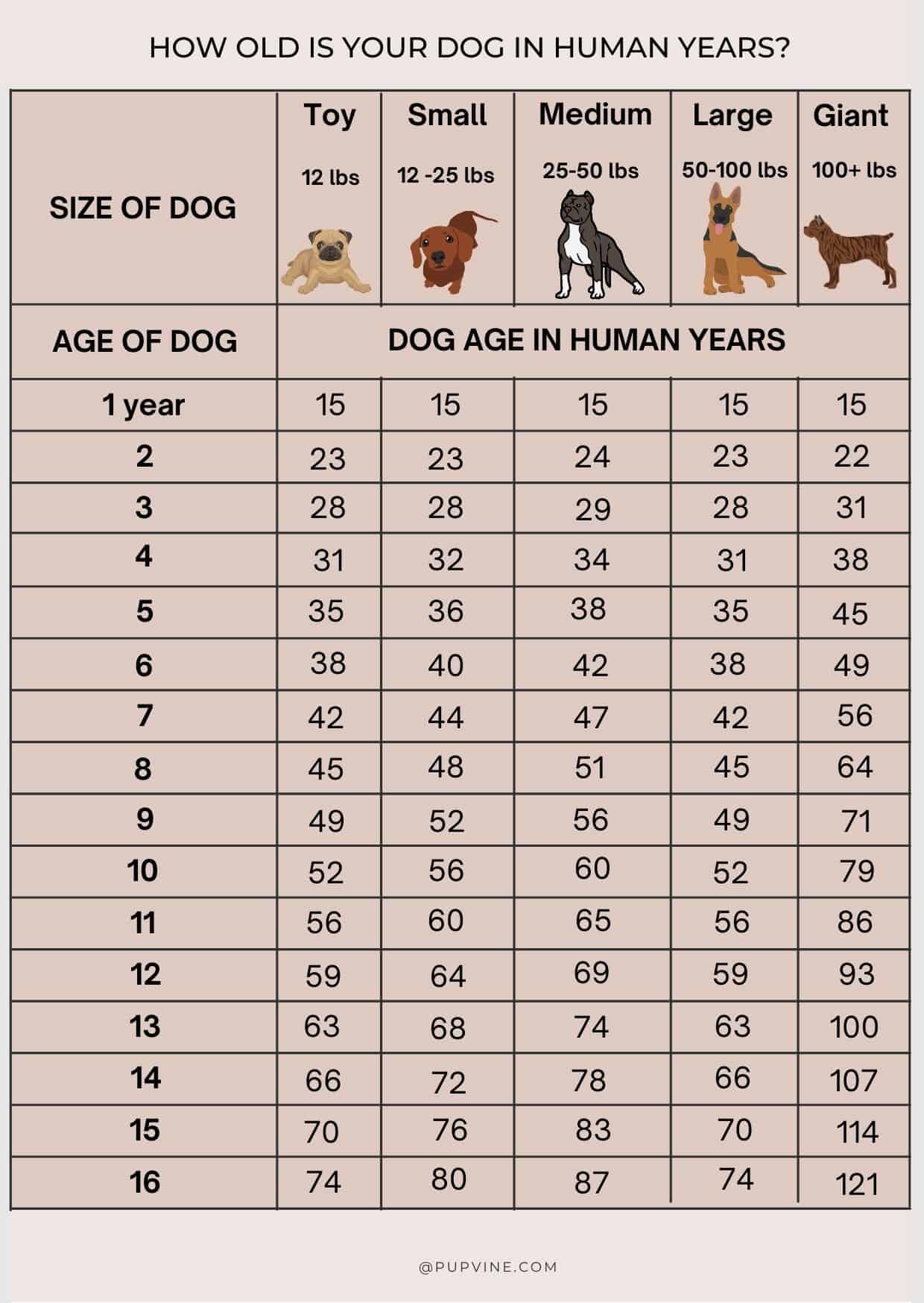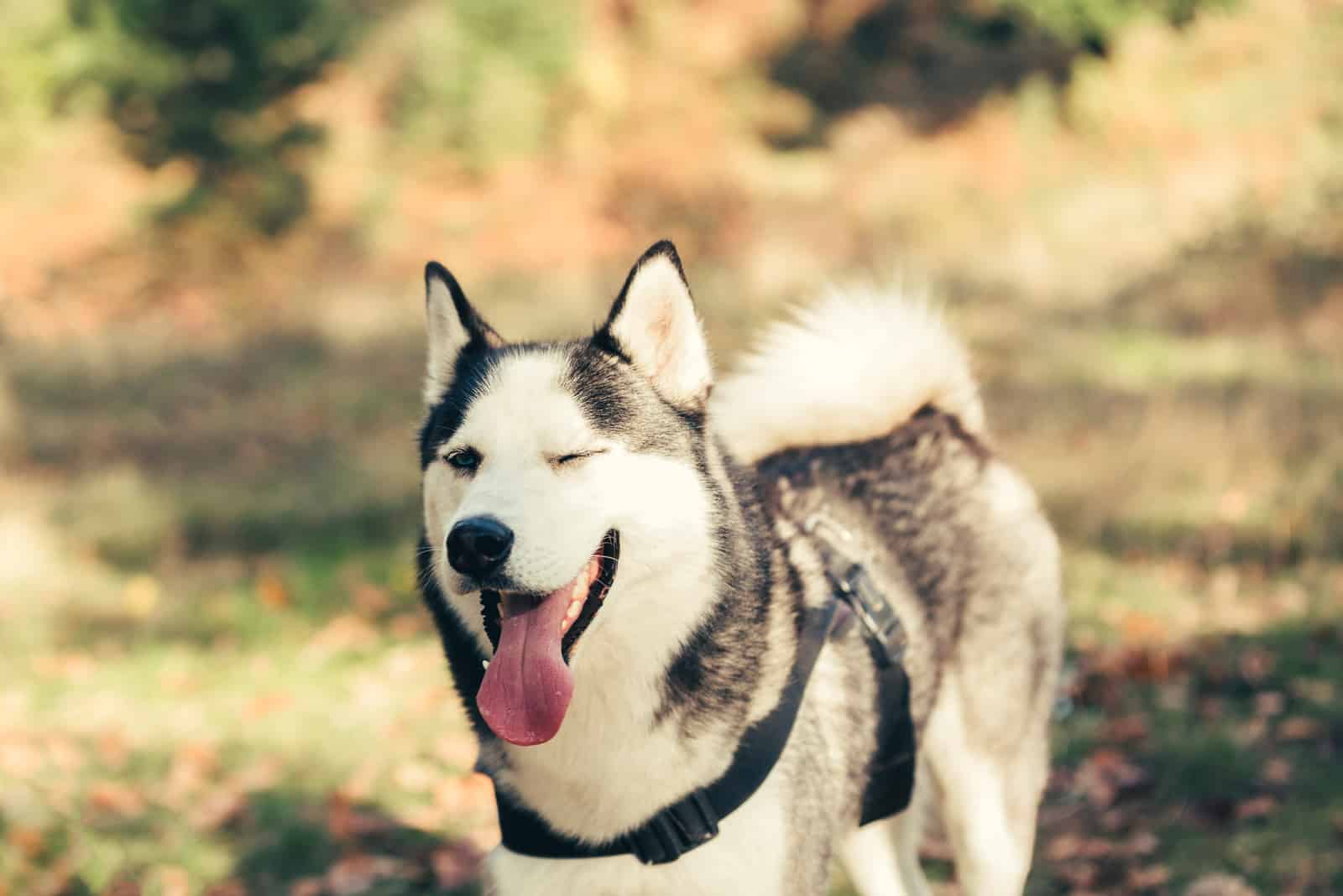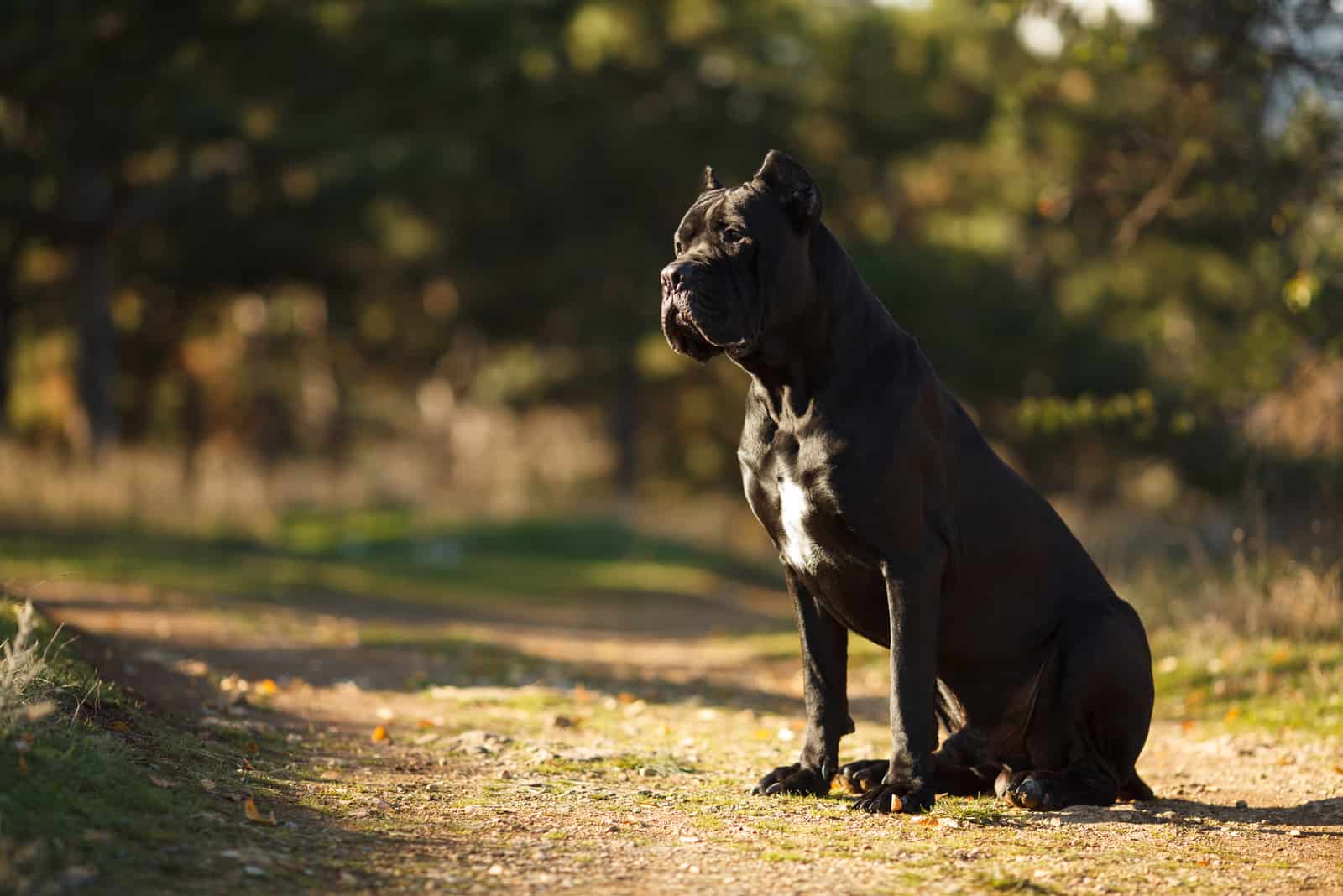You have probably heard that rule: one human year is the same as 7 dog years, right? No one knows in particular how this rule came about, but every dog owner and dog lover surely heard about it. Well, it’s time for this to change.
There are some interesting theories and studies about the conversion of dog years to human years that seem to exist for quite a long time.
Converting dog years to human years might seem easy, but there are many factors as to why this conversion can never be 100% accurate (which doesn’t make it that easy).
The most recent studies abide by the 1:15 ratio, which means that one dog year equals to 15 human years. Following this golden rule, we are able to roughly estimate dog years to human years.
Dog Years To Human Years: Dog Age Chart
Here is a dog age chart that roughly converts dog years to human years in different dog size groups. Let’s check it out:

Toy Dog Years To Human Years
[table id=499 /]
Small Dog Years To Human Years
[table id=500 /]
Medium Dog Years To Human Years
[table id=501 /]
Large Dog Years To Human Years
[table id=502 /]
Giant Dog Years To Human Years
[table id=503 /]
Dog Years To Human Years Chart Review

Now that we have these dog years to human years charts laid out in front of us, we might as well say some fun facts about each dog size group and its life expectancy (according to research, of course!).
Toy Dog Breeds Life Expectancy
Toy dog breeds are the smallest pooches that are recognized by major kennel clubs. We’re talking about Chihuahuas, Pomeranians, Toy Poodles, Yorkshire Terriers, and similar dog breeds.
The perfect example of a toy dog breed is the Pomeranian that, according to the Pomeranian growth chart, reaches up to 7 pounds once it reaches adult size.
These dogs are smaller than the official “small dog breeds”. Having said that, most toy dog breeds weigh less than 15 pounds, but can live up to 16 years on average.
According to the research from the Royal Veterinary College’s (RVC) VetCompass program, the MST (median survival time) of toy dog breeds is measured to be around 10.7 dog years on average. When we convert this into human years, toy dogs approximately live up to 54.5 in human years.
Here’s a fun fact, Chihuahuas are famous for their longevity. The longest living Chi was 21 years and 66 days old!
Small Dog Breeds Life Expectancy
Small dogs are known to be the longest living among all canines. They weigh less than 20 pounds which is believed to be the reason behind their longevity.
A recent study conducted by Dr. Silvan Urfer from the University of Washington shows that small dogs have a longer median lifespan at 16.4 dog years, which is by our calculations 82 in human years.
Results from the previously mentioned research show that amongst all small dog breeds, the Dachshund has the longest life expectancy at 15.2 dog years. When we do our math, then Dachshunds live up to 76,2 human years.
A health survey of purebred dogs conducted by the British Small Animal Veterinary Association supports the fact that small dogs live longer than larger dogs. However, the most common cause of death in small dogs is cancer.
However, small brachycephalic dogs like Pugs and French Bulldogs may have a shorter life expectancy due to breathing problems.
Medium-Sized Dogs Life Expectancy
Medium-sized dogs like Border Collies, Beagles, and Bulldogs weigh between 20 and 50 pounds. Upon reaching adulthood, Border Collies grow between 26 and 52 pounds, depending on the gender. So, this breed makes the perfect model for medium-sized dogs.
According to Dr. Urfer, MST (median survival time) of measured weight class of purebred medium size dogs equals 15.7 dog years, which is approximately 85.5 in human years.
In terms of both size and life expectancy, medium-sized dogs fall right between small dogs and large dogs.
Due to the fact that medium-sized dogs reach 56 human years when they turn 9 years old, most veterinarians recommend more frequent health-check ups.
Large Dog Breeds Life Expectancy
Large dog breeds are defined as dogs that weigh more than 50 pounds, but less than 100 pounds. The epitome of a large dog breed is the German Shepherd. As specified by the German Shepherd growth chart, these large dogs weigh between 66 and 88 pounds when they reach adulthood.
Other large dog breeds include the Golden Retriever, Cane Corso, Labrador Retriever, Rottweiler, and so on.
Using data from independent primary private veterinary clinics, Dr. Urfer and his colleagues concluded that purebred larger breeds live about 14.3 (14.1–14.8) years on average, which is by our calculations 67 in human years.
Most of us paw lovers are aware that large dog breeds are notorious for different health problems such as hip dysplasia and bloat. Health issues are one of the main reasons why large dog breeds don’t get to live as long as we would like them to.
Besides congenital and developmental health problems, researchers believe that large dogs age faster due to their rapid growth and fast metabolism.
Giant Dog Breeds Life Expectancy
Every dog that weighs more than 80 pounds and even reaches 200 pounds is considered a giant dog. For example, Newfoundland dogs grow very big in a short period of time. They can reach a whopping 150 pounds!
When it comes to giant dogs, they are the shortest living dog breeds of the canine world. Dr. Urfer’s study came to the conclusion that purebred giant dogs live up to 12.0 (11.2–13.0) on average.
Judging by our dog year conversion chart in correlation with the previously mentioned study, giant dogs live up to 93 human years! This means that a 12 year-old dog is the same as a 93 year-old human.
Giant dog breeds such as Newfoundlands, Mastiffs, Great Danes, and Saint Bernards are known to be short-living because they usually develop health problems as they age.
The Great Dane’s lifespan is only around 7 to 10 years which is already 56 to 71 in human years. When you look at the global scale, most people live about 70 years on average.
Dog Age Calculator

The easiest way for pet parents to calculate their dog’s age is by using a quick online dog age calculator. Dog age calculators can only work if you know how old your dog is in dog years and what breed it is.
When you insert the dog’s age and size, the calculator does its job in converting dog years into human years. But, how do you convert dog years of a mixed breed to human years?
Convert Dog Years To Human Years By Yourself!
You don’t have to be a math genius for this to work. If you need it, you can use a regular calculator to help you out.
Let’s start with the “15 human years is equivalent to the first year of dog’s age” hypothesis that has proven to be more accurate than the 7 year rule. Due to the fact that it is not as simple as 1 human year = X dog years, the American Veterinary Medical Association (AVMA) reminds us that this age conversion is a rough estimate.
Once a pooch reaches two years of age, that is equal to nine human years.
Therefore, the first year of your dog’s life is 15 in human years, and the second year is nine in human years. So, 15 plus 9 is 24 and that’s how old a two-year old dog is in human years.
From now on, each human year is equal to five or four dog years, depending on its size.
Why Do Large Dogs Have Shorter Lifespans?
Shorter lifespan is noticed in almost all large breeds, including the popular Labrador Retriever and Golden Retriever.
While there are many hypotheses behind this, authors of the “Size–Life Span Trade-Off Decomposed: Why Large Dogs Die Young” paper speculate that large dogs simply start aging earlier, which causes various developmental health problems that shorten their lifespan.
Higher blood concentrations of growth hormone is also linked to fast aging in large dogs. It is believed that high levels IGF-1 in large dogs is linked to increased risk of age-related health problems such as cancer and heart disease.
In contrast to that, small dog breeds don’t have high IGF-1 levels in their blood, which automatically decreases the risk of age-related health issues and prolongs their life expectancy.
Another interesting conclusion Dr. Urfer and his colleagues came about in their research is that “mixed breed survival advantage has recently been shown to be more pronounced in large and giant breed dogs”.
How Can I Tell My Dog Is Getting Old?

Dogs age gracefully. As they get old, most dogs acquire different habits from those they had when they were younger. Older dogs are not as active as younger dogs, they sleep more, and become generally calmer.
As results from the Dog Aging project paper show, as dogs get older, their physical activity lifestyle declined to 1.75 from a staggering 2.5. Moreover, the physical activity duration time that used to be more than 3.5 hours, falls down to 2.3 hours in older dogs.
Besides decreased activity levels, pet parents notice gray hairs that start appearing in their old dog’s coats.
Another thing that changes during the aging process is the color and strength of your dog’s teeth. It is not unusual for healthy older dogs to lose a few teeth!
The appearance of a dog’s teeth is not the only body part that alters during aging. Muscle mass, bone density, as well as coat quality decrease over time.
At What Age Do Dogs Start Slowing Down?
Besides a healthy lifestyle, it is usually a dog’s size that determines the most when dogs start slowing down. Most small to medium dog breeds start to slow down between seven and eight years of age. That is around 44 to 47 human years.
However, large and giant dog breeds start slowing down sooner — around 5 years of age, which is equivalent to approximately 45 human years.
Why Is Understanding My Dog’s Age Important?
Understanding your dog’s age is important because it lets you in on what goes on with its physical and mental state. In other words, understanding your dog’s age will help you figure out in which stage of life your pooch is, and compare it to your own!
While most pet parents do it for fun, converting dog years to human years actually provides better insight to the dog’s physiology and aging process.
Human and canine bodies may not be built the same, but they are undoubtedly similar in many physiological processes.
When you understand that your canine best friend has just become a senior, you will be able to provide it with all that is necessary for its old age.
The History Behind Dog Years To Human Years Conversion

There is a lot of ongoing research about dog years and the aging process. In fact, this research has been taking place since the year 1268!
The word that we are looking for here is “canine gerontology” which focuses on the dog aging process. This study includes mental and physical changes in dogs during aging, as well as behavioral changes.
Most formulas that we know of, including the 7 human years = 1 dog year rule, are based on some kind of research.
1268 Cosmati Pavement At Westminster Abbey
Back then, most studies that involved dog age didn’t have much evidence to cling on to.
The inscriptions on the Cosmati Pavement were written in Latin and they referred to the Judgment Day, in other words — the end of the world.
In these inscriptions, dog years are compared to human years and the ratio of human to dog years turned out to be 9 to 1. People knew back then that the average human lifespan was around 81 years, while dogs usually lived about 9 years of age.
18th Century Dog Years Theory
Similar theory was passed onto the 18th century when a French naturalist — Georges Buffon issued the 44-volume Histoire Naturelle (1749–1804) in which he compared the longevity of humans and dogs.
By observing both species, Georges Buffon put up a theory that humans live between 90 and 100 years on average, while dogs live from 10 to 12 years of age.
1950 Marks The Seven Year Rule
It was in the year 1950 when the famous “seven year rule” to dog years emerged. Even though a lot of time has passed, this theory still revolves around the one from the 18th century.
Only this time people lived up to 70 years on average, and dogs generally lived up to 10 years of age. So, to keep things simple and sweet for pet parents around the globe, the conversion was based on a 7:1 ratio.
Professional veterinarians unquestionably accepted this rule, but many believe they did so in order to encourage pet parents to bring their dogs for health check-ups.
1953 Changes Everything
Not all researchers agreed with the seven dog years to human years conversion rule. Three years later, the French researcher A. LeBeau made things clearer by separating each stage of life in both humans and dogs:
1. Puberty
2. Adulthood
In addition to that, LeBeau focused on the maximum lifespan of both species. He came to the conclusion that dogs age not five, not ten, but 15 to 20 times faster than humans during their first year of life!
This is something we see in growth charts of many dog breeds — major growth spurts throughout the first year of life, especially in large dogs.
To sum it up, LeBeau figured out that one dog year equals 15 human years. Dogs reach 24 years of human age when they turn two years old. After this period, each year of a dog’s life is actually four human years.
Lebeau’s results established a perfect foundation for modern canine gerontology.
2019 DNA And Life Tables Studies
Modern days bring in modern technologies and many researchers in the field of canine gerontology make use of new tools in their studies.
In 2019, Trey Ideker, Ph.D., and his colleagues at the University of California San Diego conducted a study in which they focused on dog-to-human aging comparison and came up with a new model of aging.
Based on the DNA changes in examined dogs and humans, they came up with a new way of converting dog years to human years.
Throughout their studies, researchers at the University of California San Diego figured out that an eight-weeks of age in puppies equals nine months of age in humans.
Conclusion

Learning about the dog aging process is not only about converting dog years to human years. This field of study is of great importance for both current and aspiring pet parents.
By knowing how long certain dog breeds live and how their bodies change throughout time let’s us in on what they need for a long and happy life. Moreover, it teaches us which dog breeds to choose, in terms of overall health condition.
Every pet parent’s priority is to provide their pooch with the best possible living conditions. that will prolong the dog’s lifespan. Health check-ups and healthy routines such as regular exercise and regular cleaning of the dog’s teeth have been scientifically proven to be the recipe for a canine’s long life.
Using information from various studies, as well as pet-insurance companies and veterinary hospitals helps us piece together the art of dog aging.
Converting dog years to human years makes it more fun!
